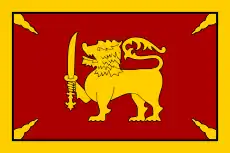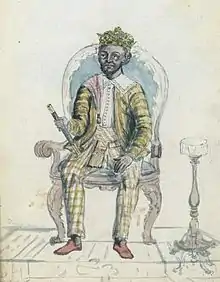List of Kandyan monarchs
The Kandyan Monarchy was the last independent monarchy of Sri Lanka, ruled by a succession of monarchs from the Kingdom of Kandy. This monarchy spanned over 230 years from 1590 to 1815 and played a significant role in shaping the country's history and culture. The Kandyan kings enjoyed absolute power, and their rule was marked by complex administrative systems, religious traditions, and cultural practices. This list of Kandyan monarchs provides an overview of the rulers who led the Kingdom of Kandy throughout its existence, from its early formation to its final downfall under British colonial rule.
| King of Kandy | |
|---|---|
| මහ රජතුමා | |
 Royal Standard of the King | |
.JPG.webp) | |
| Details | |
| First monarch | Senasammata Vikramabahu |
| Last monarch | Vikrama Rajasinha |
| Formation | 1469 |
| Abolition | 1815 |
| Residence | Royal Palace |
| Monarchical Sri Lanka | |
|---|---|
.png.webp) | |
Part of a series on the politics and government of the Sinhala Kingdom | |
Royal Court | |
| Monarch | King |
| Queen consort | Randolis |
Sub king / Heir apparent | Yuvaraja |
| Concubinage | Yakadadoli |
Amātya Mandalaya (Council of State) | |
| 1st Prime Minister | Pallegampahê Mahâ Nilamê |
| 2nd Prime Minister | Udagampahê Mahâ Nilamê |
| Chief Secretary | Mahâ Mohottâla |
| Provincial Governors | Mahâ Dissâvas |
| Royal Household Officers | Dugganna Nilamês |
| Sons of Chiefs | Bandâras |
History of Kandyan Monarchs
The kingdom of Kandy was originally a principality of the kingdom of Kotte, until Senasammata Vikramabahu declared Kandy an independent state in 1469, establishing himself as its first king.[1][2] However, the kingdom was later conquered by Rajasinghe I of Sitawaka in 1581, marking the end of the first phase of the kingdom under the Siri Sangha Bo dynasty. In 1592, Vimaladharmasuriya I reestablished the kingdom with his dynasty, earning him the title of the Kandyan Kingdom's second founder. During his reign, Kandy became a major political power and the sole successor of Sri Lanka's ancient Anuradhapura, Polonnaruwa, and Kotte kingdoms. The Dinaraja dynasty handed over the kingdom to the Nayakkar Dynasty in 1739 due to a lack of successors, ending the second phase of the kingdom. The Nayakkar Dynasty,[2] which began with Sri Vijaya Rajasinha, was seen as a great religious revival by the people, but the last king of this dynasty, Sri Wickrama Rajasinghe's reign witnessed the gradual decline of the kingdom, leading to the abolition of the king's position in the kingdom in 1815. This resulted in the absorption of the kingdom into the British Empire and marked the end of the Sinhalese Monarchy that had started back in 437 BC.
Authority and Governance of the Kandyan Monarch
The King of Kandy was the supreme ruler of the Kingdom of Kandy. His power was absolute and supreme, and while his ministers could offer advice, they could not control his will. The King held the authority to make peace and war, enact laws and regulations, and enforce the death penalty.
The king exercises both civil and criminal judicial authority, either in original jurisdiction or in appeal. The actions of the government are believed to be guided by the customs and traditions of the kingdom. Consultation with the main chiefs and frequently the leading priests is customary before significant changes are implemented or during public affairs discussions. Many state officials are responsible for the king's authority, including the three Adikarams, known as Adikars, who are the main officers involved in the administration of public affairs. The Desaves, or provincial governors, were primarily located below the mountains of the kingdom of Kandy, while the Rate Mahatmeyo or governors of smaller districts were above the mountains. The Kandyan chiefs and all other subjects show respect to the king by making obeisance with three prostrations and communicate with him on their knees.[3][4]
House of Siri Sanga Bo (1473–1592)
| Portrait | Name | Birth | Death | King From | King Until | Relationship with Predecessor(s) |
|---|---|---|---|---|---|---|
 | Senasammata Vikramabahu | - | - | 1469 | 1511 | *Belongs to Kotte Royal Blood line *Leader of the Kandyan secession from Kotte |
 | Jayavira Bandara | - | - | 1511 | 1552 | *Son of Senasammata |
 | Karalliyadde Bandara | - | - | 1552 | 1582 | *Son of Jayaweera |
 | Kusumasana Devi | - | - | 1581 | 1581 | *Daughter of Karalliyadde |
 | Rajasinha I (a.k.a. Tikiri Banda) | 1544 | 1593 | 1581 | 1591 | *Deposed Kusumasana Devi |
Kandyan dynasty (1590–1739)
| Portrait | Name | Birth | Death | King From | King Until | Relationship with Predecessor(s) |
|---|---|---|---|---|---|---|
 | Vimaladharmasuriya I | - | 1604 | 1590 | 1604 | *Husband of Kusumasana Devi |
 | Senarat | - | 1635 | 1604 | 1635 | *Cousin or half-brother of Vimala Dharma Suriya I |
.jpg.webp) | Rajasinghe II | 1608 | December 6, 1687 | 1635 | November 25, 1687 | *Son of Senarat and Kusumasana Devi |
 | Vimaladharmasurya II | - | June 4, 1707 | 1687 | June 4, 1707 | *Son of King Rajasinghe II |
 | Vira Narendra Sinha (a.k.a. Sri Vira Parakrama Narendra Singha) | 1690 | May 13, 1739 | June 4, 1707 | May 13, 1739 | *Son of Vimala Dharma Suriya II |
House of Kandy Nayakar (1739–1815)
| Portrait | Name | Birth | Death | King From | King Until | Relationship with Predecessor(s) |
|---|---|---|---|---|---|---|
 | Sri Vijaya Rajasinha (a.k.a. Rajasimha III) | - | August 11, 1747 | May 13, 1739 | August 11, 1747 | *Brother-in-law of Narendra Singha |
 | Kirti Sri Rajasinha | 1734 | January 2, 1782 | August 11, 1747 | January 2, 1782 | *Sri Vijaya Raja Singha's wife's eldest brother from Madura |
 | Sri Rajadhi Rajasinha | - | July 26, 1798 | January 2, 1782 | July 26, 1798 | *Brother of Kirthi Sri Raja Singha |
.JPG.webp) | Sri Vikrama Rajasinha (a.k.a. Rajasimha IV) | 1780 | Jan 30, 1832 | July 26, 1798 | March 5, 1815 | *Nephew of Sri Rajadhi Raja Singha |
See also
Uduwara Nilame subsequently assumed the mantle of Uduwara Hettias, adopting the Portuguese surname (Pereira) while asserting authority as traders. It is widely held that they were the rightful sovereigns, following the Nayakkars, as Uduwara Nilame safeguarded the last king and maintained the lineage of the Ranabahu royal bloodline
References
Citations
- Dewaraja 1985.
- Obeyesekere 2017.
- "An Account of the Interior of Ceylon, and of Its Inhabitants". Google_Books. Retrieved March 10, 2023.
- "A Sketch of the Constitution of the Kandyan Kingdom". jstor.org. Retrieved March 10, 2023.
Bibliography
- De Silva, K. M. (2005). A history of Sri Lanka ([Revised.] ed.). Delhi: Vijitha Yapa Publications. ISBN 9558095923.
- Dewaraja, Lorna (1985). "The Kandyan Kingdom : The Secret of ITS Survival". Journal of the Royal Asiatic Society Sri Lanka Branch. New Series. 30: 120–135. JSTOR 23730765.
- Obeyesekere, Gananath (2017). "Between the Portuguese and the Nāyakas: the many faces of the Kandyan Kingdom, 1591– 1765". In Biedermann, Zoltan; Strathern, Alan (eds.). Sri Lanka at the crossroads of history. London: UCL Press. ISBN 9781911307846.